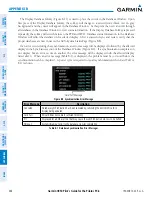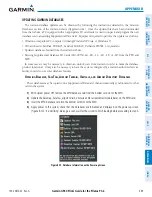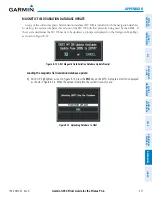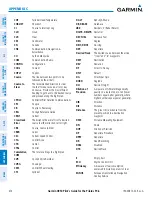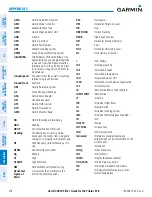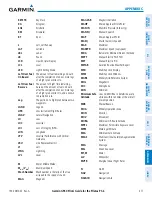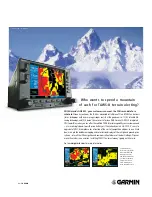
Garmin G950 Pilot’s Guide for the Pilatus PC-6
190-00870-02 Rev. A
SY
STEM
O
VER
VIEW
FLIGHT
INSTRUMENTS
EIS
AUDIO P
ANEL
& CNS
FLIGHT
MANA
GEMENT
HAZARD
AV
OID
ANCE
AFCS
ADDITIONAL FEA
TURES
APPENDICES
INDEX
482
APPENDIX D
For RAIM to work correctly, the GPS receiver must track at least five satellites. A minimum of six satellites is
required to allow RAIM to eliminate a single corrupt satellite from the navigation solution.
RAIM ensures that satellite geometry allows for a navigation solution calculation within a specified protection
limit (2.0 nm for oceanic and en route, 1.0 nm for terminal, and 0.3 nm for non-precision approaches). The
G950 System monitors RAIM and issues an alert message when RAIM is not available (see Appendix A). Without
RAIM, GPS position accuracy cannot be monitored. If RAIM is not available when crossing the FAF, the pilot
must fly the missed approach procedure.
W
hat
is
gsl
altituDe
?
GSL (Geodetic Sea Level) altitude is the height above Mean Sea Level (MSL), as calculated geometrically,
generally using a global positioning system (GPS) as the primary data source. The calculated result may or may
not include a barometric component, but the primary source is geometric.
W
hy
Might
there
Be
no
aPProaches
aVailaBle
for
a
flight
Plan
?
Approaches are available for the final destination airport in a flight plan or as a direct-to (keep in mind
that some VOR/VORTAC identifiers are similar to airport identifiers). If a destination airport does not have a
published approach, the G950 indicates “NONE” for the available procedures.
W
hat
haPPens
When
an
aPProach
is
selecteD
? c
an
a
flight
Plan
With
an
aPProach
,
a
DeParture
,
or
an
arriVal
Be
storeD
?
When an approach, departure, or arrival is loaded into the active flight plan, a set of approach, departure,
or arrival waypoints is inserted into the flight plan, along with a header line showing the title of the selected
instrument procedure. The original enroute portion of the flight plan remains active, unless the instrument
procedure is activated. This may be done either when the procedure is loaded or at a later time.
Flight plans can also be stored with an approach, a departure, or an arrival. Note the most recent active flight
plan is restored when the system is turned on, if the aircraft position is the same as the origin airport in the most
recent active flight plan. Also, the active flight plan is overwritten when another flight plan is activated. When
storing flight plans with an approach, a departure, or an arrival, the system uses the waypoint information from
the current database to define the waypoints. If the database is changed or updated, the system automatically
updates the information, provided the procedure has not been modified. Should an approach, departure, or
arrival procedure no longer be available, the flight plan becomes locked until the procedure is deleted from the
flight plan.
c
an
“
slant
g
olf
” (“/g”)
Be
fileD
using
the
g950?
“/G” may be filed for a flight plan. The G950 system meets the requirements of TSO-C145a Class 3 or TSO-
C145c Class 3, and ETSO C145 Class 3 installations. GPS approaches are not to be flown with an expired
database. See the approved AFM as well as the Aeronautical Information Manual (AIM) for more information.
W
hat
Does
the
oBs s
oftkey
Do
?
The
OBS
Softkey is used to select manual sequencing of waypoints. Activating OBS mode sets the current
active-to waypoint as the primary navigation reference and prevents the system from sequencing to the next
waypoint in a flight plan. When OBS mode is cancelled, automatic waypoint sequencing is continued, and the
G950 automatically activates the next waypoint in the flight plan once the aircraft has crossed the present active
waypoint.

